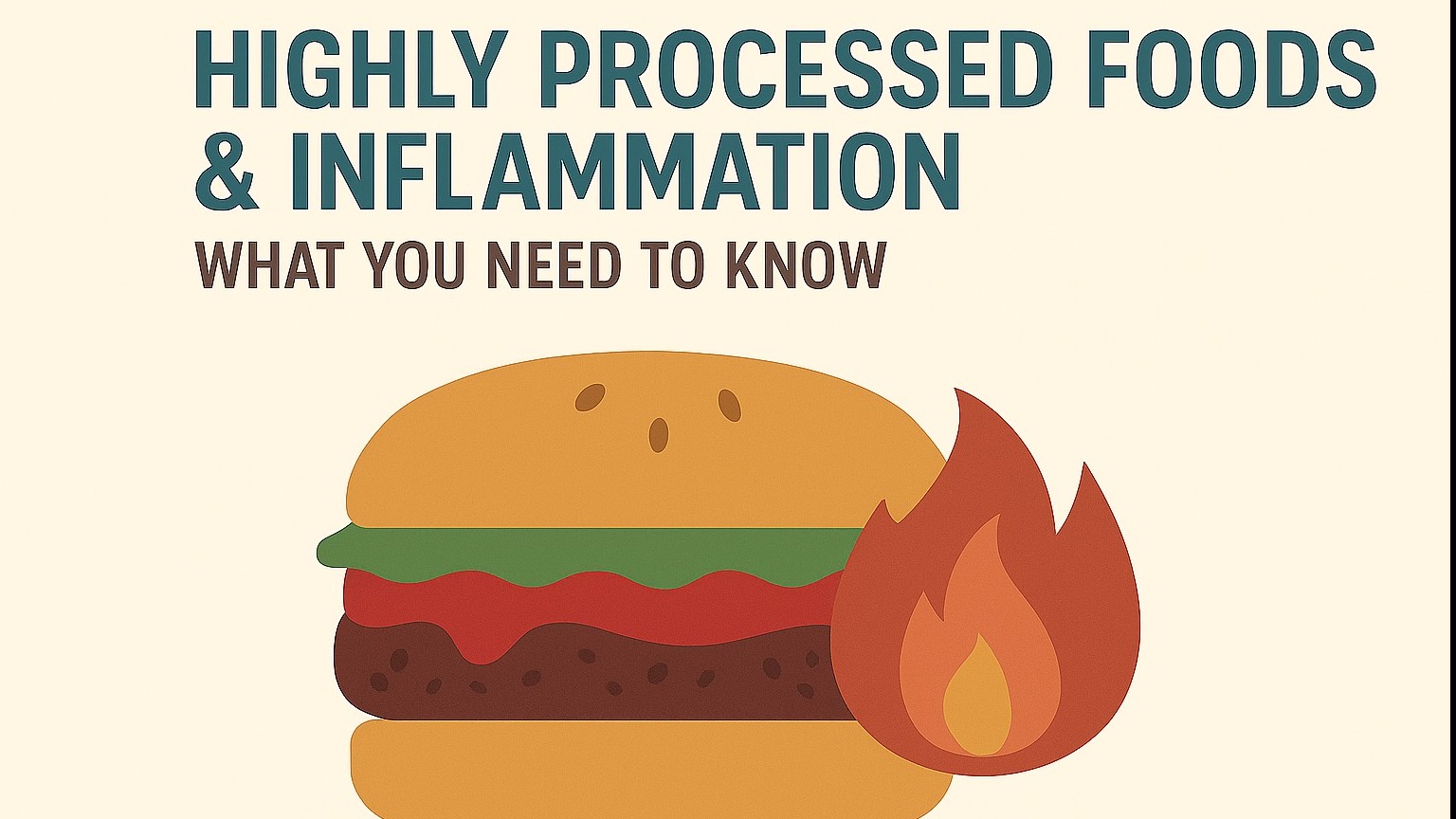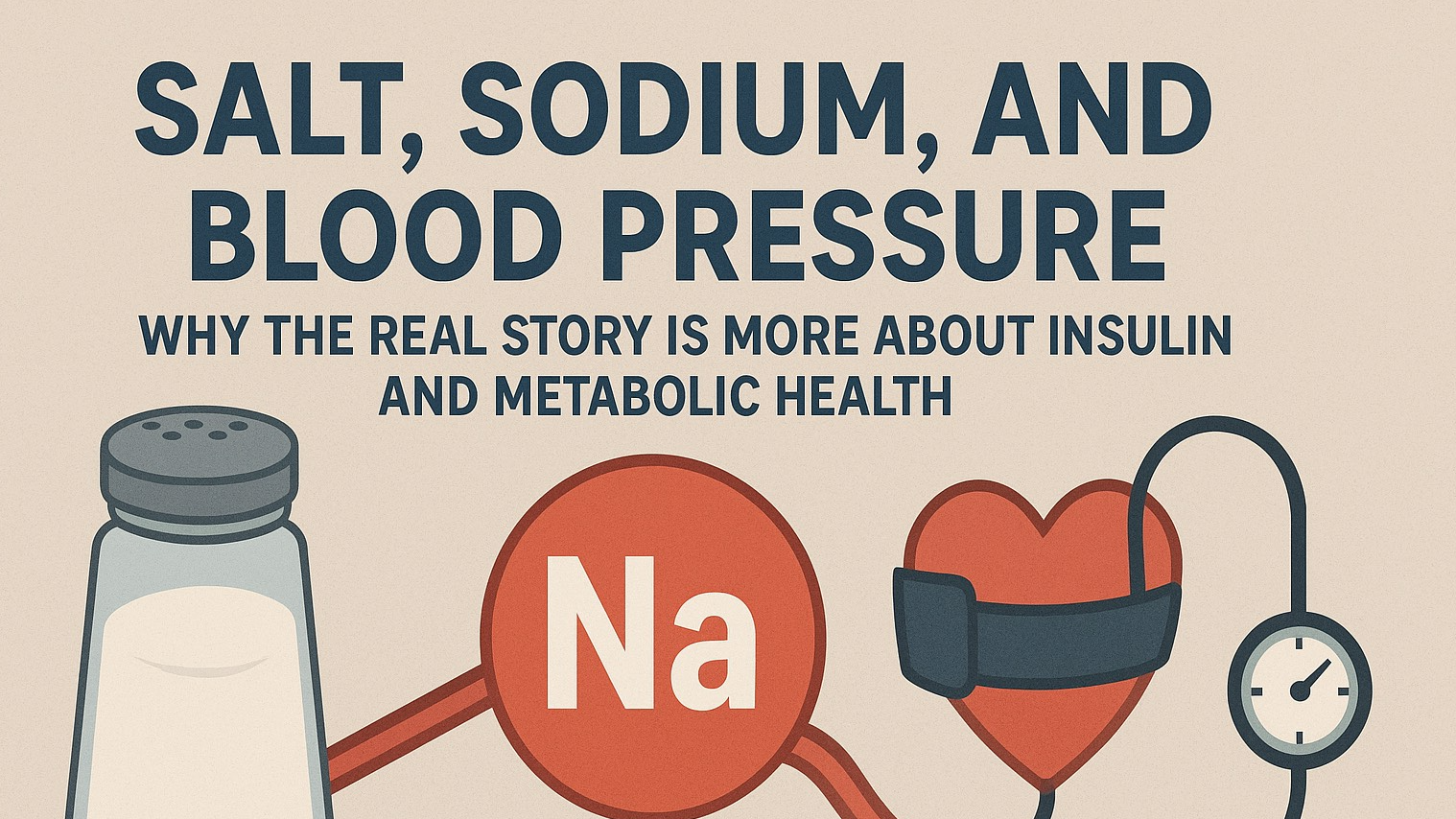
By Kim Larson — Larson Health
Let’s Talk Real for a Minute
Hey friend, Kim here 👋. Let’s have an honest talk about something that affects almost all of us: highly processed foods. These are the foods that come in flashy packages, usually with long ingredient lists, and they’re so common in today’s diet that we barely notice them anymore.
The problem? They keep our bodies in a state of chronic, low-grade inflammation—and that “fire inside” can set the stage for conditions like arthritis, diabetes, dementia, heart disease, and even autoimmune flares.
Don’t worry, I’m not here to guilt-trip you out of ever eating chips again. I’m here to give you the facts, in plain English, and show you simple swaps you can make this week that calm inflammation and help you feel like you again.
What Are “Highly Processed Foods”?
Researchers call them ultra-processed foods (UPFs). These aren’t just frozen veggies or plain canned beans (those are fine, by the way!). UPFs are foods that are:
Built from refined starches/sugars, industrial oils, and additives
Low in fiber, vitamins, and minerals
Designed to be hyper-palatable (you know, the “can’t eat just one” effect)
Think: sodas, packaged pastries, sweetened yogurts, chips, energy bars, fast food, frozen pizza, flavored cereals, and many packaged snacks.
Studies link high UPF intake to more inflammatory markers in the blood and higher risk of chronic disease.
Why Do Processed Foods Stoke Inflammation?
1. Blood Sugar Rollercoaster
All that refined sugar and white flour sends your blood sugar spiking, then crashing. Over time, this rollercoaster pushes your immune system into a “low simmer” of inflammation.
➡️ Want to see how I help balance blood sugar with food? Check out my recipe for Steak Bites & Mashed Sweet Potatoes.
2. Gut Irritants from Additives
Some common food additives like carboxymethylcellulose (CMC) and polysorbate-80 (often in packaged ice creams, dressings, and sauces) have been shown to thin the gut lining and irritate the microbiome. When the gut lining is irritated, the immune system turns on.
3. Advanced Glycation End Products (AGEs)
When foods are cooked at high, dry heat (like fried fast food), they form compounds called AGEs. Too many AGEs = more oxidative stress and inflammation in your body.
4. Damaged Oils from Deep Frying
It’s not just the oil—it’s the process. Reheated oils (like in fast food fryers) break down into compounds that are toxic to our cells.
➡️ Listen to my podcast episode “Fasting Hacks You Need to Know About” where I talk more about how food quality matters during fasting.
Diseases Linked to Inflammation
Arthritis: Western, processed diets are linked with more joint pain and swelling. Mediterranean-style eating (more whole foods, olive oil, fish) reduces inflammation.
Type 2 Diabetes: More UPFs = higher risk of insulin resistance and diabetes.
Dementia: Studies show higher UPF intake increases dementia risk, while whole-food diets lower it.
Heart Disease & Autoimmune Issues: Chronic inflammation from diet plays a huge role in both.
What You Can Do This Week
My “Calm the Fire” Basics
Crowd in whole foods. Build meals around protein + colorful plants + healthy fats (like olive oil, nuts, avocado).
-
Swap UPFs for upgrades:
Soda → sparkling water + splash of juice
Packaged cookies → apple slices + almond butter
Processed deli meats → roasted chicken or beans
White crackers → whole grain options
Check labels. If you see CMC or polysorbate-80, put it back.
Cook wetter. Stew, steam, or braise more often to lower AGEs.
Fiber is your friend. Aim for 25–35g/day from plants and whole grains.
Copy and Printable: Your Quick Guide
UPF Swap List
Soda → Sparkling water + fruit
Chips → Air-popped popcorn
Packaged sweets → Fruit + nuts
Processed meats → Lentils, beans, roasted poultry
White bread → Whole grain sprouted bread or gluten free bread
Additives to Watch
Carboxymethylcellulose (CMC)
Polysorbate-80
High-fructose corn syrup
Artificial colors/flavors
👉 Download this printable card here
Final Thoughts
You don’t have to be perfect. Functional medicine isn’t about restriction—it’s about making swaps that give your body what it needs to cool the fire. If you start by reducing UPFs and focusing on colorful, whole foods, you’ll see inflammation markers drop, energy rise, and long-term risk for arthritis, diabetes, and dementia shrink.
And remember—every small choice counts.
Call to Action
If you’re ready to learn more about how to lower inflammation with food, subscribe to my podcast at Larson Health Podcast or check out my latest recipe Pesto & Hummus Turkey Roll Ups.
By Kim Larson — Larson Health
Let’s Talk Real for a Minute
Hey friend, Kim here 👋. Let’s have an honest talk about something that affects almost all of us: highly processed foods. These are the foods that come in flashy packages, usually with long ingredient lists, and they’re so common in today’s diet that we barely notice them anymore.
The problem? They keep our bodies in a state of chronic, low-grade inflammation—and that “fire inside” can set the stage for conditions like arthritis, diabetes, dementia, heart disease, and even autoimmune flares.
Don’t worry, I’m not here to guilt-trip you out of ever eating chips again. I’m here to give you the facts, in plain English, and show you simple swaps you can make this week that calm inflammation and help you feel like you again.
What Are “Highly Processed Foods”?
Researchers call them ultra-processed foods (UPFs). These aren’t just frozen veggies or plain canned beans (those are fine, by the way!). UPFs are foods that are:
Built from refined starches/sugars, industrial oils, and additives
Low in fiber, vitamins, and minerals
Designed to be hyper-palatable (you know, the “can’t eat just one” effect)
Think: sodas, packaged pastries, sweetened yogurts, chips, energy bars, fast food, frozen pizza, flavored cereals, and many packaged snacks.
Studies link high UPF intake to more inflammatory markers in the blood and higher risk of chronic disease.
Why Do Processed Foods Stoke Inflammation?
1. Blood Sugar Rollercoaster
All that refined sugar and white flour sends your blood sugar spiking, then crashing. Over time, this rollercoaster pushes your immune system into a “low simmer” of inflammation.
➡️ Want to see how I help balance blood sugar with food? Check out my recipe for Steak Bites & Mashed Sweet Potatoes.
2. Gut Irritants from Additives
Some common food additives like carboxymethylcellulose (CMC) and polysorbate-80 (often in packaged ice creams, dressings, and sauces) have been shown to thin the gut lining and irritate the microbiome. When the gut lining is irritated, the immune system turns on.
3. Advanced Glycation End Products (AGEs)
When foods are cooked at high, dry heat (like fried fast food), they form compounds called AGEs. Too many AGEs = more oxidative stress and inflammation in your body.
4. Damaged Oils from Deep Frying
It’s not just the oil—it’s the process. Reheated oils (like in fast food fryers) break down into compounds that are toxic to our cells.
➡️ Listen to my podcast episode “Fasting Hacks You Need to Know About” where I talk more about how food quality matters during fasting.
Diseases Linked to Inflammation
Arthritis: Western, processed diets are linked with more joint pain and swelling. Mediterranean-style eating (more whole foods, olive oil, fish) reduces inflammation.
Type 2 Diabetes: More UPFs = higher risk of insulin resistance and diabetes.
Dementia: Studies show higher UPF intake increases dementia risk, while whole-food diets lower it.
Heart Disease & Autoimmune Issues: Chronic inflammation from diet plays a huge role in both.
What You Can Do This Week
My “Calm the Fire” Basics
Crowd in whole foods. Build meals around protein + colorful plants + healthy fats (like olive oil, nuts, avocado).
-
Swap UPFs for upgrades:
Soda → sparkling water + splash of juice
Packaged cookies → apple slices + almond butter
Processed deli meats → roasted chicken or beans
White crackers → whole grain options
Check labels. If you see CMC or polysorbate-80, put it back.
Cook wetter. Stew, steam, or braise more often to lower AGEs.
Fiber is your friend. Aim for 25–35g/day from plants and whole grains.
Copy and Printable: Your Quick Guide
UPF Swap List
Soda → Sparkling water + fruit
Chips → Air-popped popcorn
Packaged sweets → Fruit + nuts
Processed meats → Lentils, beans, roasted poultry
White bread → Whole grain sprouted bread or gluten free bread
Additives to Watch
Carboxymethylcellulose (CMC)
Polysorbate-80
High-fructose corn syrup
Artificial colors/flavors
👉 Download this printable card here
Final Thoughts
You don’t have to be perfect. Functional medicine isn’t about restriction—it’s about making swaps that give your body what it needs to cool the fire. If you start by reducing UPFs and focusing on colorful, whole foods, you’ll see inflammation markers drop, energy rise, and long-term risk for arthritis, diabetes, and dementia shrink.
And remember—every small choice counts.
Call to Action
If you’re ready to learn more about how to lower inflammation with food, subscribe to my podcast at Larson Health Podcast or check out my latest recipe Pesto & Hummus Turkey Roll Ups.
 Add Row
Add Row  Add
Add 










Write A Comment